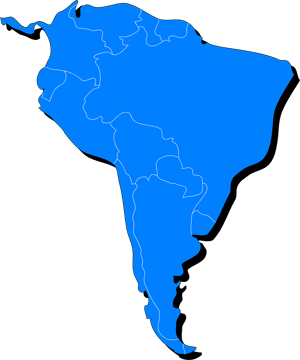Itaguyra occulta
Every month, 100,000 readers use the Dinosaur Database, but we receive no support from you. Developing and updating the database requires a lot of work. If you want it to remain open and be updated, please support us via the "Buy us a coffee" button available on every page or via the Support page.
Dinosaur: Itaguyra occulta

| Length*: | 1.5 m | 4.9 ft |
| Weight*: | 20 kg | 44 lb |
*The largest known specimen
Period
Epoch: Late Triassic
Stage: Carnian
Years: 237–227 Ma
Details
Status: valid
Author: Paes Neto et al.
Year: 2025
Distribution
Area: South America
Country: Brazil
Region: Rio Grande do Sul
Formation: Santa Maria
Classification
Description
Itaguyra occulta
Itaguyra occulta is an early-diverging member of the dinosaur lineage, assigned to the enigmatic group informally known as “silesaurids”. It was discovered in the Santa Cruz Sequence of the Paraná Basin in southern Brazil, and dates to the early Carnian stage of the Late Triassic, approximately 236 million years ago. The genus name derives from the Tupi words ita (stone) and guyra (bird), while the species name occulta (Latin for “hidden”) alludes to the specimen’s long-unrecognized status within a fossil collection.
Itaguyra provides a crucial data point within Triassic vertebrate evolution, filling a temporal and geographic gap in the fossil record of “silesaurids” between the older Pinheiros-Chiniquá Sequence and the later Candelária Sequence faunas of Brazil. This taxon supports the hypothesis that ornithischian-like dinosauromorphs were present and ecologically established in South America well before the major diversification of true dinosaurs.
Geographic Location
Type locality: Schoenstatt Sanctuary fossil site, Santa Cruz do Sul, Rio Grande do Sul, Brazil
Physical Characteristics
Itaguyra occulta is known from a partial pelvis, comprising:
- Left ilium (holotype UFRGS-PV-1365(a)-T)
- Associated left ischium (paratype UFRGS-PV-1365(b)-T)
While no complete skeleton is preserved, the pelvis shows a combination of primitive and derived traits characteristic of “silesaurids”:
- A faint preacetabular crest linking to a curved supracetabular crest (rather than a prominent ridge)
- Postacetabular process subequal in height to the acetabulum, unlike in most other “silesaurids”
- Laterally visible brevis fossa with a distinctive triangular posterior process
- A tall, robust ischial shaft, proportionally short proximodistally, with slight distal expansion
These features distinguish Itaguyra from closely related genera such as Gamatavus, Lutungutali, and Silesaurus.
Due to the absence of limb or cranial material, the body size of Itaguyra is uncertain. Based on comparisons with similar “silesaurids,” it may have reached approximately 1.2–1.5 meters (3.9–4.9 feet) in length and weighed 10–20 kg (22–44 lbs).
Diet and Feeding Habits
Like other “silesaurids”, Itaguyra occulta was likely herbivorous or omnivorous. Its pelvic structure suggests a bipedal or facultatively quadrupedal posture. While no teeth are known from the holotype, closely related taxa exhibit beak-like jaws and simple leaf-shaped teeth adapted to cropping vegetation. This implies Itaguyra fed on low-lying plant material, possibly including ferns, seed ferns, or gymnosperms.
Habitat and Distribution
Itaguyra lived during the early Carnian in what is now southern Brazil, within the Santa Cruz Sequence of the Santa Maria Supersequence. This unit represents ephemeral fluvial and loessic deposits formed in a semi-arid to arid environment with seasonal variation.
Key paleoenvironmental features included:
- Loessic plains with intermittent river systems
- Seasonal dry-wet cycles
- A fauna dominated by cynodonts (advanced non-mammalian synapsids), dicynodonts, and proterochampsids
Itaguyra was part of the Santacruzodon Assemblage Zone, a biozone characterized by non-dinosaurian tetrapods just prior to the explosive diversification of true dinosaurs.
Behavior and Social Structure
There is no direct evidence of behavior, but Itaguyra occulta likely occupied a low-tier herbivorous niche. It may have lived solitarily or in small groups, browsing amid sparse Triassic vegetation. Its anatomy suggests good mobility, potentially aiding in predator avoidance.
The persistence of “silesaurids” across several South American biozones suggests these animals were ecologically adaptable and capable of withstanding regional faunal turnovers during the Late Triassic.
Discovery and Research
The fossil was collected from the Schoenstatt outcrop in Santa Cruz do Sul, Rio Grande do Sul, Brazil. Though originally unrecognized, it was re-examined and described in 2025 by Voltaire Paes Neto and colleagues.
The pelvic elements had been misidentified as indeterminate cynodont remains but were later reclassified as belonging to a dinosauromorph, and ultimately described as a new genus and species.
Phylogenetic analysis places Itaguyra near the base of Ornithischia, within a paraphyletic array of early “silesaurids”, further supporting recent hypotheses that some “silesaurids” may be early ornithischian dinosaurs.
Significance and Notable Facts
- First dinosauromorph from the Santa Cruz Sequence
- Fills a key temporal gap between Middle and Late Triassic “silesaurid” records
- One of the earliest potential ornithischians in South America
- Helps clarify the transition from dinosaur precursors to true dinosaurs
- Named for its avemetatarsalian affinities (“stone bird”) and previously hidden status (“occulta”)
Conclusion
Itaguyra occulta is a small but significant addition to the Triassic dinosauriform record of South America. By occupying an intermediate temporal and phylogenetic position, it helps bridge the evolutionary gap between early avemetatarsalians and the true dinosaurs that would later dominate Mesozoic ecosystems. Its discovery underscores the importance of reexamining overlooked specimens and contributes to a growing picture of pre-dinosaur diversity in Gondwana.
Locations
Sources
Material: left ilium, left ischium
References: Paes Neto, V.D. et al. (2025). Continuous presence of dinosauromorphs in South America throughout the Middle to the Late Triassic. Scientific Reports



